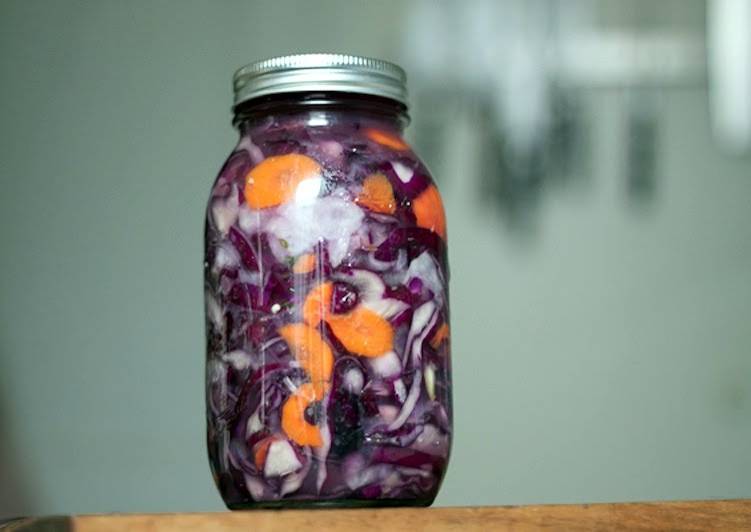Kimchi
Steps Making Recipes Kimchi using 7 ingredients and 19 steps
Kimchi - Mak kimchi, or simple kimchi, is made with cut cabbage, radish, and scallions and a seasoned paste of red pepper, garlic, ginger, sugar, and fish sauce, salted shrimp, or kelp powder. (Image credit: Apartment Therapy ) Kimchi (/ ˈ k ɪ m tʃ iː /; Korean: 김치, romanized: gimchi, IPA: ), a staple in Korean cuisine, is a traditional side dish of salted and fermented vegetables, such as napa cabbage and Korean radish, made with a widely varying selection of seasonings including gochugaru (chili powder), spring onions, garlic, ginger, and jeotgal (salted seafood), etc. It is also used in a variety of soups. Kimchi, a popular Korean dish, is best described as a spicy, slightly sweet, pickled or fermented cabbage. I spent a year in South Korea and fell in LOVE with Kimchi! My friend Myong was kind enough to share her recipe and technique with me.

Its tasty, spicy flavor makes it an ideal additional to rice, noodles, soup, and other dishes that need a little something extra.
Full of healthy, gut-healing probiotics, the benefits of eating kimchi are endless.
You can have Kimchi using 7 ingredients and 19 steps. Here is how you cook it.
Ingredients cook Kimchi
- Prepare 3 lb Red cabbage.
- Prepare 3/4 lb Daikon radish.
- It's 1/2 lb Yellow onion.
- It's 5 to 10 cloves Garlic.
- It's 1/2 lb Carrots.
- It's 2 to 6 Thai Chilis.
- Prepare 2 tbsp Kosher Salt or Sea Salt.
Kimchi instructions
- Start by slicing the red cabbage in half, then quarters, so it'll be easier to work with..
- Slice all of the cabbage into strips about 1/4" thick. Put the cabbage into a bowl and set it aside..
- Slice all the daikon radish into thin coins. We slice everything super thinly to create as much surface area as possible! This will make it easier for the salt to do its work. The thicker it is, the longer it'll take to ferment..
- Add the radish to the same bowl as the cabbage..
- Trim and peel all of the onion. Thinly slice the onion and add it to the bowl..
- Peel all of the carrot..
- Now slice the carrot into thin coins and add it to the bowl..
- Peel 5-10 cloves of garlic, depending on how strong you like it, and smash the cloves..
- Add the garlic to the other vegetables in the bowl..
- Mince 2-6 Thai chilis into a fine paste. You'll start by cutting them into small slices then going over it all again with your knife to mince it even more finely..
- Add the chili to the bowl..
- It's time to mash those vegetables. Add 1/8 cup of salt (that's 2 tbsp) to the vegetables..
- Use your hands to squeeze and mash the vegetables and salt. Continue to do this until the vegetables start to leach water..
- Once water has leached out of the vegetables, set the bowl aside for 30 minutes. This will allow the salt to draw more water out of the vegetables. Clean up and relax!.
- After the 30 minutes are up, tightly pack the vegetables into your 1 quart mason jar. Make sure there is enough liquid in the jar so that the vegetables are submerged..
- Put the lid on the jar and place it on your kitchen counter. Leave it at room temperature for at least 7 days. The bacteria need to be at room temperature to multiply and ferment..
- At least once a day, slowly open the lid to release the gases that build up. Hold your jar in the sink when doing this, for it’s sure to spray! Be sure to taste the ferment periodically. Once it tastes right to you, put it in your fridge..
- If the water level of the ferment drops below the vegetables, just add more of the mixture if you have any left over. If not, just add more water along with a pinch of salt, until the vegetables are submerged..
- Be sure to take a before and after picture of your kimchi. Watch it change color over time - it's a fascinating process. Post it on Twitter or Instagram with the hashtag #fermentfeast and we'll share it on the website..
Kimchi - Kimchi is a traditional Korean dish made with salted, fermented vegetables. It typically contains cabbage and seasonings like sugar, salt, onions, garlic, ginger, and chili peppers. Kimchi is a traditional Korean dish of fermented vegetables, the most common of which are napa cabbage and daikon radish (but check out other types of kimchi). In addition to being served as banchan, Korean side dishes presented as part of a meal, it can also be used in a variety of cooked dishes. Try it as a sauce for Brussels sprouts, with braised short ribs, or in Korean tofu soup. This kimchi recipe is made with baechu (배추), known as napa cabbage, hence the name baechu kimchi. Because the cabbage is kept intact at its head, it's also known as pogi kimchi (포기김치). Thank you and good luck